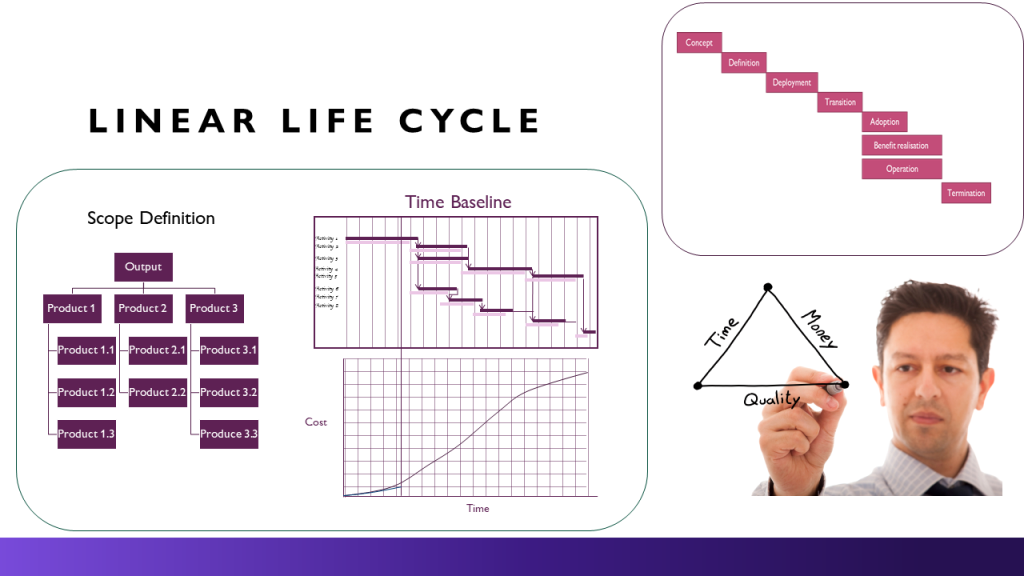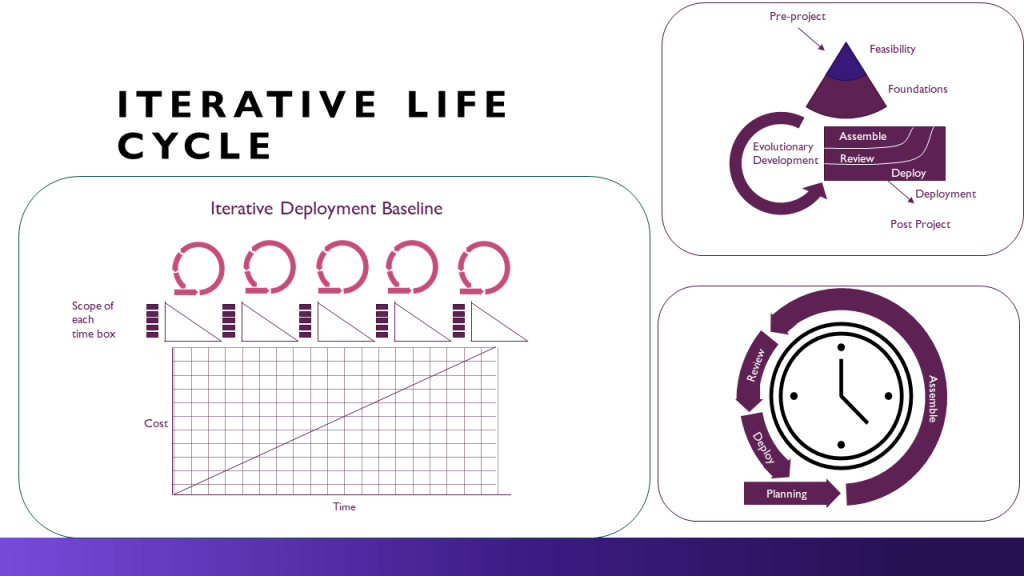The APM Body of Knowledge 7th edition introduced a new term deployment baseline and defined it as:
Deployment baseline:
Agreeing the integrated plan to enable managed deployment.
APM Body of Knowledge 7th edition
https://www.apm.org.uk/resources/what-is-project-management/what-is-planning/
It’s a new phase for many many project managers, especially when applied to both linear and iterative lifecycles. So in this blog post we are going to explore in a little more detail:
- What is a deployment baseline?
- What are the components of a deployment baseline for linear and iterative life cycles?
- Compare and contrast the approaches to project baselines.
What is a deployment baseline?
A deployment baseline is simple the plan for the execution of the project. It supports the project management plan and typically sets out the baselines plans for the project. These normally include scope, timeline and budget. Although I prefer to add requirements to this as part of the scope. It’s important that these baselines be agreed for a number of reasons:
- They provide an opportunity for senior management, the sponsor and steering group to review and sign off the plan. This reduced the risk of issues emerging later in the project or confusion about the actual commitment.
- They form the basis of communication with other team members so they understand the planned work.
- They help communicates to stakeholders such as users and operational staff the overall plan for the project. Without this communication, stakeholders can feel a bit left in the dark about want is happening.
- The requirements form the basis of the expected performance for the system. Thys confirm what is going to be delivered and when.
How does a project manager establish a deployment baseline?
The approach to the formation of a deployment baseline varies between different project approaches. For a linear approach then the use of baselines is well understood, for iterative projects the concept of baselines are less established.
Deployment Baselines for Linear Life Cycle Projects

Linear lifecycles from a step by step approach. The project starts with a concept and business case and then proceeded to develop a project management plan (PMP) and baselines during the definition phase. Once the PMP is approved these baselines are then used as part of the project control cycle to deliver the project in line with the plan during the deployment (or implementation phase). The aim during this phase is to control (and minimise changes), minimise risk and address any emergent issues. The hope is that by the end of the deployment phase the plan will have been delivered without too much damage within the agreed budget, time and cost.

Hence the components of the deployment baseline in a linear project are:
- Scope definition is developed as a comprehensive list of all the project deliverables, normally done as a product breakdown structure or a work breakdown structure. The aim of a linear life cycle is the lockdown this scope definition at the end of the definition phase. And then careful control any changes, risk and /or issue that may cause the project to divert off-plan.

- The schedule normally presented as a Gannt chart. Typically the baseline plan is shown below the current forecast for comparison. Variations from the plan can be tracked and monitored. However, this is a bit of an oversimplification because often a rolling wave technology is used to progressible develop work packages a step at a time based on feedback from earlier stages. In many ways the mirrors exactly what we see in iterative approaches.

Deployment Baselines for Iterative Life Cycle Projects

For an iterative life cycle, the approach is more evolutionary. The project starts with three early stages.
- Pre-project which check that the project fits with organisations strategy, the resources are available. It results in a gateway much like a linear lifecycle.
- Feasibility will look at the technical and commercial feasibility of the project. It is technically possible in a reasonable timescale. her we create rough estimates of the overall cost and timeline. Again not dissimilar from the concept stage of a linear lifecycle.
- Foundation focuses on refining the high-level requirements, developing any proof of concept studies for novel technology, using MOSCOW prioritisation to identify the must-have, should have requirements and scheduling the time boxes, including a rough idea of how many iterations and the duration of each iteration, how many resources are needed for each iteration and what skills are required for each stage.

Iteration Phases
The project then enters a number of time-boxed iteration phases, during which the versions of the solution are built, reviewed by the users and other stakeholders then deployed. This cycle is repeated and the solution refined until it meets the needs of the users at which point it will often be deployed to a wider audience.

What is an Iterative Deployment Baseline?

So what would be in an iterative deployment baseline?
- The first element of a deployment baseline is a plan for how many iterations will be required to deliver the necessary functionality and what the development road map will be for each iteration. For example, the first stage might be to develop the basic data analytics functionality while later stages may focus on developing a graphical user interface.
- The second part will be the different skills needed at each iteration. So for example in the first iteration, we might need the skills of a data scientist, database developer, firmware engineer, while later iteration may need a graphical user interface designer and ergonomics design. This will be important for project resource planning.
- The final part will be the cost plan for the project. This might be linear with the same costs planned for each iteration, but if the skills change then different team member might have different costs. These different costs will need to be incorporated into the plan for the project.
Summary
In summary, the differences between linear and iterative deployment baselines are:
Deployment Baseline Summary
Linear Life Cycle
- Fixed scope, timeline and budget (mostly).
- Control changes and risk to stay within the baseline.
- Scope fully developed before the start.
- Good for projects with known requirements and known delivery method
Iterative
- Budget and timeline fixed at the start (mostly)
- The scope varies with each iteration dependent on feedback
- Can be difficult to predict when the project will finish (if ever)
- Good for projects with known delivery methods but poorly defined scope.
When you get down to the details, the similarities between linear and iterative lifecycles are, in my opinion, more significant than the differences.